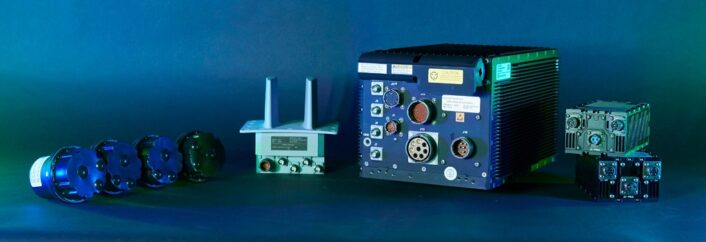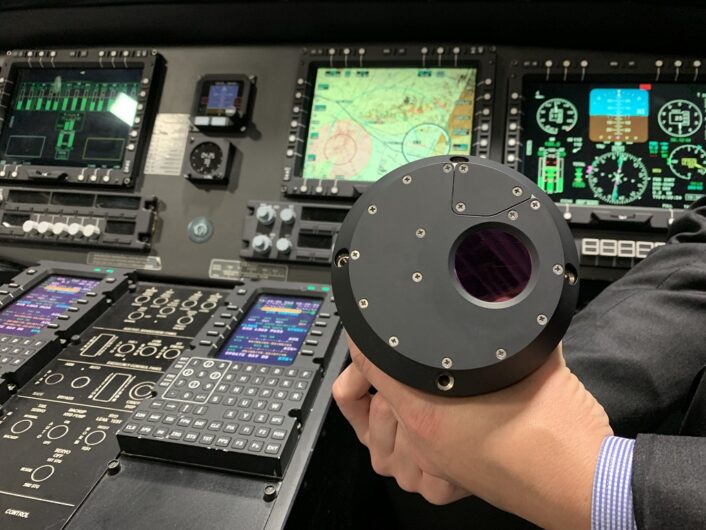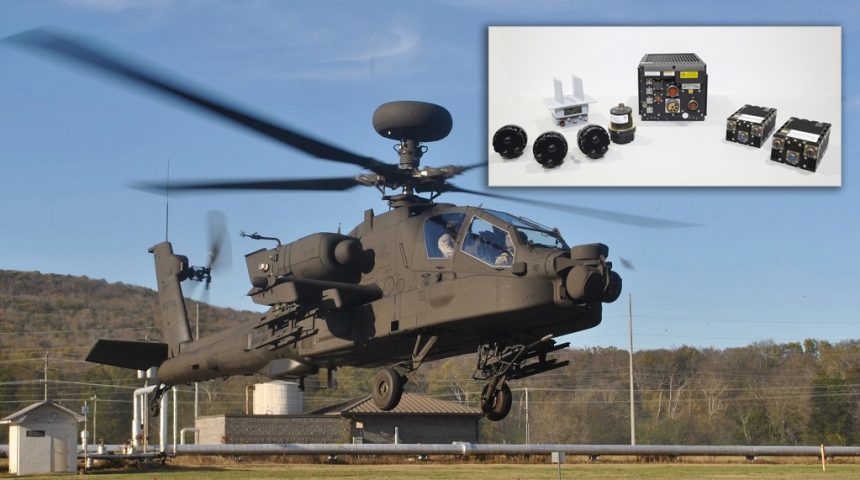The new system is set to replace the legacy APR-39C(V)1 currently fielded on U.S. Army aviation assets.
The U.S. Army awarded Northrop Grumman a five-year contract to begin the initial production of the AN/APR-39E(V)2 digital Radar Warning Receivers, announced the company earlier this year. The AN/APR-39E(V)2, also called the Modernized Radar Warning Receiver by the Army, is an enhanced, fully digital variant of the AN/APR-39D(V)2, a partially digital RWR that the service adopted as a bridging technology to start replacing the currently fielded 25-year-old APR-39C(V)1.
The initial Radar Signal Detecting Set contract was awarded in August 2023, followed in December by a $106.5 million modification for production, engineering, and technical and logistic support services. Northrop Grumman confirmed to us that the contract includes the production of over 50 units for the Army’s AH-64E Apache Guardian attack helicopter fleet.
The system is currently in test and evaluation and planned to undergo Follow-on Operational Test in 4QFY24 and First Unit Equipped in 4QFY27, according to the Army’s Project Management Office Aircraft Survivability Equipment. The APR-39E is set to provide Army aviation with state-of-the-art radar threat detection, with a significant advance in survivability.
“The APR-39E(V)2 is a sophisticated, more agile radar warning receiver that outpaces emerging threats,” said James Conroy, vice president, navigation, targeting and survivability, Northrop Grumman. “It provides a generational leap in capability over previous radar warning systems.”
We had a chance to talk about the new AN/APR-39E(V)2 with Northrop Grumman and to know something more about this digital radar warning receiver.

The AN/APR-39E(V)2 digital Radar Warning Receiver
The AN/APR-39E(V)2 is the next step in the evolution of the AN/APR-39, the radar warning receiver and electronic warfare controller that has been protecting US and foreign aircraft for decades. The program’s origin dates to 2019, when the U.S. Army awarded the first contract to Northrop Grumman to start the development.
The APR-39E is one of the systems that the Army’s PM ASE is working on to modernize Aircraft Survivability Equipment and better maintain pace with aircraft threats which are becoming increasingly sophisticated and lethal. Specifically, under the Modernized Radar Warning Receiver program, the APR-39E will detect, categorize, and prioritize Radio Frequency emitters to provide visual and aural alerts to the aircrew, warning them of targeting by Radio Frequency (RF)-guided weapons.
The AN/APR-39E(V)2 is designed to detect radar threats, such as radar ground sites and particularly radar-guided missiles and guns, and provide 360-degree coverage around the aircraft. Accurate and timely radar warnings allow aircrews to recognize Radio Frequency threats in time to deploy the appropriate countermeasures and perform evasive maneuvers to defeat the threat.
The full APR-39E system consists of a processor, two receivers, a dual blade low band antenna and four quadrant antennas, according to PM ASE. The quadrant antennas are usually installed on the nose and tail, while the dual blade antenna is installed on the underside of the aircraft.
The antennas detect the RF energy, and the signal is then sorted and processed in order to classify the threat, determine its intent and prioritize the detected threats by lethality to the aircraft. Then, the system alerts the pilots by providing the information with a graphic symbol on the cockpit display together with aural warnings.
The Army says the APR-39E provides seven times higher instantaneous band width over the APR-39D(V)2, increased overall receiver performance against frequency agile RF threats and AESA radars, increased detection range. The system also offers an open VPX backplane which enables Open Architecture for future growth and is interoperable with RF electronic countermeasures.
Given the current trend of AI and cognitive electronic warfare, we asked about the use of these technologies in the APR-39E and Conroy told us that includes additional processing capacity for new algorithms and functionality. Cognitive electronic warfare and machine learning techniques can be added to the APR-39E(V)2, and Northrop Grumman plans to integrate these capabilities in a secure and responsible way.
Northrop Grumman further mentioned the APR-39E’s smart antenna detects threats over a wide range of the spectrum, including millimeter wave frequencies, for a broader view of potential threats. The system is also capable of sharing threat data, enhancing survivability and mission effectiveness in multi-domain, large-scale combat operations.
As a sidenote, the Army’s PM ASE mentions that the AN/APR-39E(V)2 is also the detect system hardware for the F-16’s AN/ALQ-257 Integrated Viper Electronic Warfare Suite. Northrop Grumman says this technology is shared across a family of EW systems and can be scaled to virtually any platform or mission, confirming to us that they were able to adapt the technology to protect a wide range of aircraft, from uncrewed platforms up to transport-category aircraft.

Multispectral protection
Given the current threat environment, it is important for aircraft to have complete protection against both RF and IR threats to ensure the highest survivability. Last year, the Common Infrared Countermeasures (CIRCM), also produced by Northrop Grumman, reached the Initial Operational Capability with the U.S. Army, paving the way for its accelerated fielding on more than 1,500 Army aircraft.
CIRCM is a lightweight dual-jammer Directional Infrared Counter Measures (DIRCM) system designed specifically to protect rotary wing and medium fixed wing aircraft from infrared-guided missiles. The dual-jammer configuration was chosen as it provides spherical protection and the highest level of aircraft survivability, compared to a single head DIRCM.
CIRCM is a 5th gen DIRCM system which can defeat both current and emerging IR-guided missile threats. In fact, CIRCM has also been proposed for the installation on the Future Vertical Lift helicopters, together with the AN/APR-39E(V)2 digital Radar Warning Receiver/Electronic Warfare Management System.
When installed together, APR-39E(V)2 and CIRCM can provide protection against both IR and RF threats, significantly enhancing aircraft survivability. Conroy told us that Northrop Grumman has already demonstrated the ability of the APR-39E(V)2 to cue CIRCM to the location of a potential IR threat.
In addition to CIRCM, as Electronic Warfare Management System, the AN/APR-39E(V)2 can also be integrated with missile warning sensors. Northrop Grumman is currently developing the Advanced Tactical Hostile Engagement Awareness (ATHENA) for the Army’s Improved Threat Detection System competition.
ATHENA is a staring sensor, able to detect threats beyond infrared guided missiles, including hostile fire and anti-tank guided missiles. The longer range, processing power and resolution of ATHENA provides an additional margin of safety in contested airspace.
The system, which Northrop Grumman calls the “eyes of CIRCM”, is able to detect and identify supersonic missiles almost instantaneously, providing additional time for warfighters and survivability systems to address threats and greater maneuverability. ATHENA provides the ability, similarly to the F-35’s Distributed Aperture System, to view any point in 360 degrees around the aircraft and even “look through” the aircraft floor.
To efficiently integrate these systems, Northrop Grumman developed a capability called SAINT, Survivability Against Integrated and Network Threats, to provide always-on, multispectral threat data to the aircrew. It integrates information from ATHENA and APR-39(E(V)2 to allow the crew to reroute or deploy appropriate countermeasures, and it can be hosted in AN/APR-39E(V)2.









